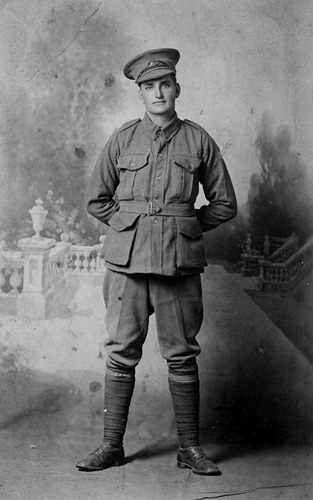Born in Orange in 1895, Charles Campbell enlisted at Holsworthy on 8 September 1915. He embarked from Sydney three months later, proceeding to Egypt as a Private in the 19th Battalion, 8th Reinforcements.
On 16 February 1916 Charles was transferred to the 54th Battalion of the Australian 5th Division at Tel-el-Kebir near Cairo. It was here that Charles became best friends with another young man from the Orange district, Albert Leslie Singleton.
The 5th Division had been assigned to take over defence of a section of the Suez Canal. Commanding officer Major General McCay decided to turn this into a training exercise and on 28 March 1916 ordered the entire Division to march the 65 kilometres through the desert to Moascar in full battle kit in 40 degree heat. Many of the soldiers suffered heat exhaustion, and in the evening, ambulance wagons and camels collected these soldiers from the desert where they had collapsed.
On 19 June 1916 the 54th Battalion embarked from Alexandria on the Caledonian, to join the British Expeditionary Forces in France, arriving at Marseilles on 29 June. They were then marched up to the front line at Fleurbaix.
Without any time to acquaint themselves with their surroundings, the Battalions of the 5th Division were assigned to attack the fortified German lines. This action is now known as the Battle of Fromelles. (Fleurbaix and Fromelles are 5km apart, the former behind the British lines and the latter behind German lines). They were assembled to attack in four waves at five minute intervals. The first wave was to take the first German trench and clear it of the enemy. Subsequent waves of attackers were to leap-frog the first trench and take second and third German support trenches that had been identified from aerial reconnaissance.
A seven-hour long artillery bombardment of the German lines began at 11am on 19 July. The Germans, however, were aware of the troops massing in the trenches opposite, preparing to attack, and their artillery soon found their range and caused significant casualties amongst the waiting Australians.
At 5.45pm the order to attack was issued and the 54th Battalion – Charles and his mates – “hopped the bags” (went over the top).
They achieved their objectives, but found that the second and third German support trenches didn’t exist – they were shallow water-filled ditches providing them little cover from German rifles and machine guns. Nonetheless, they attempted to defend these ditches, digging into the gluey Flanders clay and filling sand bags from which to construct a parapet. Night fell at around 9pm.
As morning broke on 20 July, at 7.50am the Battalion was ordered to retreat. Private Charlie Campbell was wounded that evening, sustaining gunshot wounds to the head and chest. Charlie survived his injuries; he was hospitalised in Boulogne, then transferred to Colchester General Military Hospital at Aldershot in Hampshire. He was discharged in August and rejoined his unit in November.
Charles’ best friend, Albert, was not so lucky; he was one of 155 deaths that the 54th Battalion suffered during the attack.
In January 1917 Private Campbell was transferred to 5th Australian Division Traffic Control Detachment with rank of Sapper.
Charles Campbell returned to Australia in June 1919. He resumed farming and orcharding on Pinnacle Road with his brothers Vic and Raymond, and in 1924 married Kathleen Mary Fitzgerald.
* Robert Cunneen, 2016
Leader, 22 November 1916, p. 6.
The Village Blacksmith’s Tree: Canoblas Soldier photographed under it by an ex-Orange Clergyman.
Leader, 13 June 1919, p.8.
Canoblas Heroes



Keep up the good work
Cheers
Phil